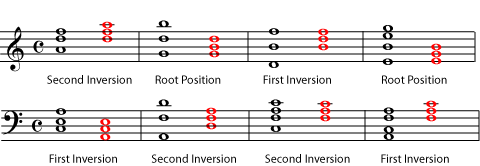| << Chapter < Page | Chapter >> Page > |
Harmony in Western music is based on triads. Triads are simple three-note chords built of thirds .

The chords in [link] are written in root position, which is the most basic way to write a triad. In root position , the root , which is the note that names the chord, is the lowest note. The third of the chord is written a third higher than the root, and the fifth of the chord is written a fifth higher than the root (which is also a third higher than the third of the chord). So the simplest way to write a triad is as a stack of thirds, in root position.
Write a triad in root position using each root given. If you need some staff paper for exercises you can print this PDF file .


Any other chord that has the same-named notes as a root position chord is considered to be essentially the same chord in a different position . In other words, all chords that have only D naturals, F sharps, and A naturals, are considered D major chords.

It does not matter how far the higher notes are from the lowest note, or how many of each note there are (at different octaves or on different instruments); all that matters is which note is lowest. (In fact, one of the notes may not even be written, only implied by the context of the chord in a piece of music. A practiced ear will tell you what the missing note is; we won't worry about that here.) To decide what position a chord is in, move the notes to make a stack of thirds and identify the root.
Rewrite each chord in root position, and name the original position of the chord.



Notification Switch
Would you like to follow the 'Introduction to music theory' conversation and receive update notifications?